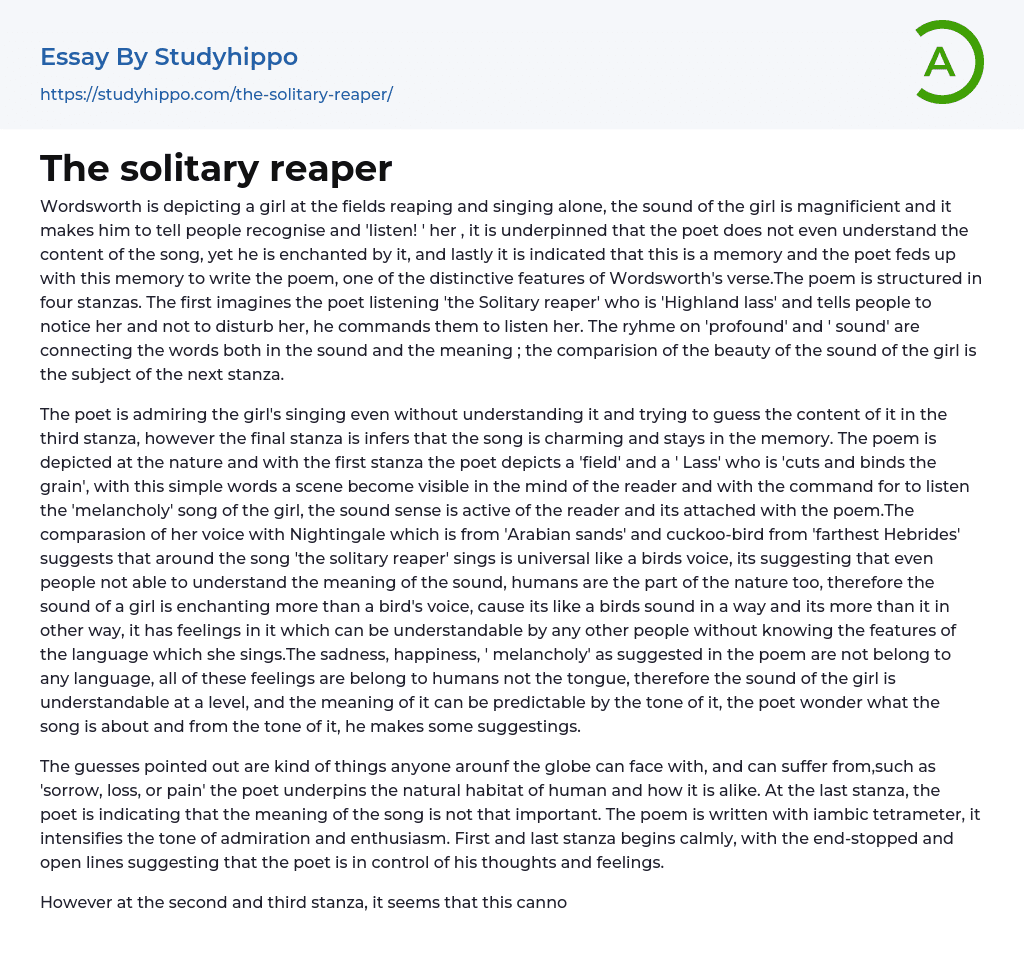In Wordsworth's poem, he portrays a solitary girl singing and harvesting in the fields. Despite not comprehending her song's meaning, it captivates him with its loveliness. He encourages others to also listen to her and take inspiration from his personal encounter. The poem contains four stanzas that demonstrate Wordsworth's mastery of poetry. The initial stanza emphasizes the importance of appreciating the "Highland lass" without disturbance. In the second stanza, he draws parallels between the meanings and sounds of "profound" and "sound." The third stanza compares the beauty of her voice through description.
In the poem, a "field" and a "Lass" are depicted by the poet as she cuts and binds the grain. Vivid imagery is used to create an image in the reader's mind while also urging them to listen to her mournful melody. Despite not understanding its m
...eaning, the poet admires her singing in the third stanza and tries to guess what it is about. The final stanza concludes that her voice is charming and unforgettable, comparing it to those of birds from different regions such as a Nightingale from "Arabian sands" and a cuckoo-bird from the "farthest Hebrides." This suggests that her song has universal appeal like that of birds' voices, representing nature as part of humanity itself. Her captivating voice embodies emotions such as sadness, happiness, and melancholy that are universally human rather than specific to any one language or culture. Therefore based on its tone alone he predicts its meaning even though he does not know what she sings about exactly.
The poet emphasizes that the challenges mentioned, like 'sorrow, loss, or pain', are universal experiences that affect people worldwide. This underscores
the inherent similarities in human nature. In the final stanza, the poet implies that the significance of the song is irrelevant. The poem utilizes iambic tetrameter to enhance the tone of admiration and enthusiasm. The first and last stanzas commence serenely with lines that are both end-stopped and open. This conveys that the poet remains composed and in charge of their emotions and thoughts.
The poem's second and third stanzas overflow with bursts of emotion that extend into subsequent lines, conveying an exuberant and joyful mindset. The primary focus of the poem is on the praise of mountains, pastures, and nature, yet it additionally explores the ways in which beauty and memory impact the poet. As is characteristic of works by Wordsworth and other nature-focused poets, the theme centers on the relationship between nature, humanity, and their influence on human memory. The enjambments present throughout the poem suggest spurts of emotion.
- Boo Radley essays
- Genesis essays
- Richard iii essays
- Alice in Wonderland essays
- On the road essays
- Ozymandias essays
- The Nightingale essays
- Holden Caulfield essays
- Animal Farm essays
- 1984 essays
- A Hanging essays
- Shooting An Elephant essays
- A Tale Of Two Cities essays
- Adventures Of Huckleberry Finn essays
- Arthur Conan Doyle essays
- Brave New World essays
- Characters In Hamlet essays
- Characters In Romeo And Juliet essays
- Desdemona essays
- Diary Of A Wimpy Kid essays
- First-Person Narrative essays
- Frankenstein essays
- Heart Of Darkness essays
- Jane Eyre essays
- Jay Gatsby essays
- King Duncan essays
- Librarian essays
- Little Red Riding Hood essays
- Lord Of The Flies essays
- Silas Marner essays
- The Cask Of Amontillado essays
- The Catcher In The Rye essays
- The Crucible essays
- The Handmaid's Tale essays
- The Reader essays
- Virgil essays
- Wuthering Heights essays
- Candide essays
- Castle essays
- J. D. Salinger essays
- Ulysses essays
- Ethan Frome essays
- In Cold Blood essays
- Outliers essays
- Tuesdays With Morrie essays
- The Art of War essays
- Wife of Bath essays
- Huckleberry Finn essays
- The Lady With The Dog essays
- Great Expectations essays




